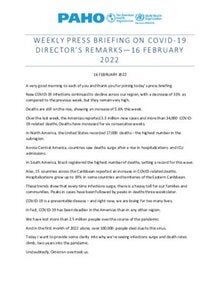Weekly Press Briefing on COVID-19: Director's Opening Remarks, February 16, 2022

|
A very good morning to each of you and thank you for joining today’s press briefing. New COVID-19 infections continued to decline across our region, with a decrease of 31% as compared to the previous week, but they remain very high. Deaths are still on the rise, showing an increase of 5.6% this week. Over the last week, the Americas reported 3.3 million new cases and more than 34,000 COVID-19-related deaths. Deaths have increased for six consecutive weeks. In North America, the United States recorded 17,000 deaths – the highest number in the subregion. Across Central America, countries saw deaths surge after a rise in hospitalizations and ICU admissions. In South America, Brazil registered the highest number of deaths, setting a record for this wave. Also, 15 countries across the Caribbean reported an increase in COVID-related deaths. Hospitalizations grew up to 19% in some countries and territories of the Eastern Caribbean. These trends show that every time infections surge, there is a heavy toll for our families and communities. Peaks in cases have been followed by peaks in deaths three weeks later. COVID-19 is a preventable disease – and right now, we are losing far too many lives. In fact, COVID-19 has been deadlier in the Americas than in any other region. We have lost more than 2.5 million people over the course of the pandemic. And in the first month of 2022 alone, over 100,000 people died due to this virus. Today I want to provide some clarity into why we’re seeing infections surge and death rates climb, two years into the pandemic. Undoubtedly, Omicron overtook us. The variant spread more quickly than others, and we are dealing with a greater volume of cases than ever before. Unfortunately, as Omicron arrived, we didn’t use all the tools we had developed to slow the spread and prevent infections for the new kind of transmission patterns that Omicron presents. Too many places in our region remained just as they were before this wave: people relaxed their precautions, traveled, and gathered and met indoors, often unmasked, creating opportunities for transmission. The truth is that the reduced public health measures were insufficient to reduce the scale of this wave. And now, we are dealing with the consequence: A rise in infections is driving a surge in deaths. As we saw throughout the pandemic, the elderly and people living with comorbidities face the highest risk. In every country across the region, more than half of the deaths in this surge occurred in people over the age of 65. But age is not the only factor. Many people in our region remain unprotected against COVID and have yet to receive lifesaving vaccines. Unvaccinated people of all ages are still filling up our hospitals and ICU beds and too many are succumbing to this virus. But today we have better tools to fight COVID, and countries have the experience that they need to control infections. Omicron has shown that the vaccines that we have at hand can protect most of us from severe illness and death. 14 countries and territories in our region have already immunized more than 70% of their eligible populations. We are on track to help other nations reach that mark and must continue to strive for equitable access so that we can reach everyone. We have now delivered 100 million doses of COVID-19 vaccines to 33 countries in Latin America and the Caribbean, thanks to the work of PAHO’s Revolving Fund in coordination with COVAX. We are also thankful for donations of vaccines from nine countries, which made up 30% of that 100 million dose milestone. In addition to promoting vaccinations, countries also know how to adjust hospital systems to accommodate new surges, while making sure health workers have the protection and knowledge to safely treat COVID patients. And we know that public health measures–like physical distancing, limiting large gatherings and promoting mask wearing – work to slow the spread. The hard thing is enacting these measures quickly. We need to activate our responses more rapidly to keep pace with the current wave, and stay ahead of future surges, of this very fast, very serious virus. And that’s why we’re urging countries to focus on filling in critical gaps in vaccination coverage. To meet the WHO’s 70% coverage target for every country, our region must ensure that at least 20 million more people receive all their vaccine doses. Countries need to focus on expanding coverage in high-risk groups, like health workers and the elderly, to help save lives and to protect hospital capacity. We won’t overcome this pandemic unless we protect these groups, and then go beyond to cover everyone who is eligible. We must also remember the importance of effective public health and social measures to drive down transmission. We’re still feeling the weight of Omicron. It is more important than ever to sustain the public health measures that we know work against this virus. And speed is of the essence because this variant is proof of how quickly the situation can change. Inaction is not an option when up to 34,000 people have died from this virus each week during the last few weeks in the Americas. And that means that up to 202 people have died every hour in this region. We know how to slow transmission, to protect people with vaccines and how to provide better care to those who are sick. We need to act quickly and decisively to save lives. This will not be the last variant, and the future of the pandemic is still extremely uncertain. The choices we make today can have ripple effects for months and years to come.
|
